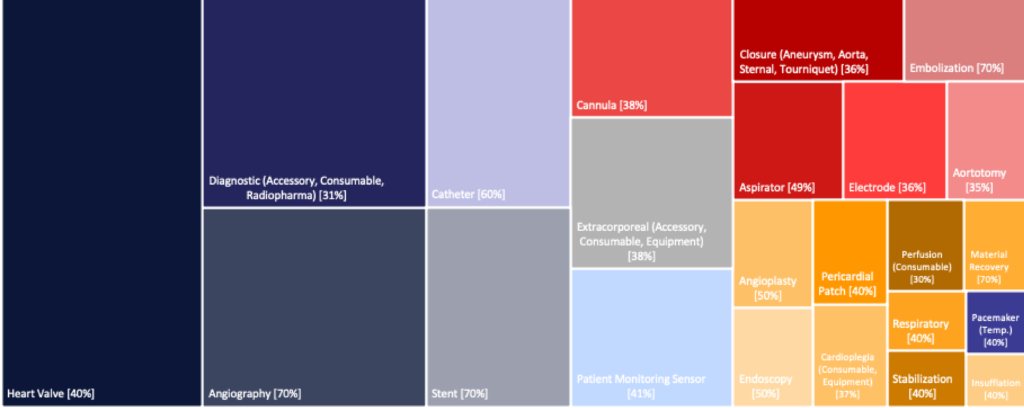Tenders Weighted Toward VBP Criteria for Cardiovascular Disease
As a result of an aging population, increased chronic illnesses and disabilities, there is currently increased spending in the health sector coupled with a shortage of medical staff. Cardiovascular diseases, specifically, account for 5,000 deaths each day in Europe with a cost of more than €200 billion annually (source: European Heart Network). While policy and regulation are important to reduce critical risk factors such as smoking and obesity in the long-term, tying spending to clinical outcomes within tenders can introduce more value into healthcare systems in the near-term. These non-price criteria are referred to as value-based procurement (VBP); which is closely linked to the ‘most economically advantageous tender’, or MEAT, concept. This cost-effectiveness approach yields the ‘best’, not necessarily lowest, price, with the most effective outcomes.
Cardiovascular Disease and Meat-Based VBP Criteria
In a recent presentation to the MedTech Europe working group, Vamstar discussed how to identify tenders with non-price criteria using artificial intelligence (AI)—this is important because most tenders with non-price criteria are not labeled as ‘VBP’. Across all of Europe, Vamstar’s platform recognized that 4% of healthcare and life sciences tenders featured non-price criteria in 2020. Narrowing the regional focus to the EU5, Nordics, and Netherlands revealed a much higher share at 16.6%. Sharpening the focus to cardiovascular disease, the share increases further to 48% for the same year. These numbers indicate that MEAT-based VBP has been gaining traction in recent years; for cardiovascular disease in particular.
A search for the term ‘cardiovascular disease’ in Vamstar’s AI platform produces a useful example of VBP’s increased usage.

This chart shows the analysis of nearly 300 lots for MEAT-based VBP criteria, relating to the years 2020 and 2021, in the EU5. The share of quality criteria is relatively high in tenders related to cardiovascular disease, being at 48% in 2020 (42% as of October 2021). Quality expectations are anticipated to continue increasing again at the end of this year.
Although MEAT-based VBP features in only small share of all European contracts, it is far more prevalent in specific regions of Europe and in medical sectors like cardiovascular disease. However, despite the apparent benefits of VBP, there are still barriers to implementation.
Challenges in Scaling VBP
- The Need for transparent outcomes – 73% of buyers and suppliers agree that contract outcomes, outcome criteria, need to be clearly defined to achieve VBP. As of today, this is not the case for most tenders.
- Speed of operation – Most buyers still incorporate manual processes with only 12% having electronic systems in place that are capable of achieving VBP. This figure must increase for VBP to be achieved at a faster pace.
- Lack full cost of care criteria – Only 30% of MEAT-based VBP contracts feature the full cost of care criteria with clear ROI metrics. Not all tenders with non-price criteria operate as full VBP tenders. These can be missed opportunities, slowing overall VBP growth.
- Issues related to business models – 60% of buyers do not have value rewarding payment models and they often take considerable time to design VBP programs. They do not necessarily know what they want from VBP, preventing it from being fully implemented.
AI-Based Solutions
An AI-based VBP solution can get around these issues. It can simulate outcomes through continuous monitoring and extraction of key outcomes across major therapy areas. This data can be used to create contracts between buyers and suppliers, increasing the pace at which VBP is adopted in procurement. AI can also measure performance through integrated data, intelligence and automated workflows for buyers and suppliers.
Vamstar has developed its own AI to enable the automation and scaling of VBP contracting. Vamstar scans millions of buyer contracts in 109 languages from hospitals, clinics, private websites, contract registries, e-sourcing platforms, and distributor databases. The AI finds data on direct sourcing arrangements, VBP contracts, innovation framework agreements, procurement contracts, RFPs, tenders, tender awards, and pre-tender notices. The technique quickly finds concealed trends that humans may not recognize. Such trends inform contracts. ML-based projections are then also possible. The data is processed by natural language processing (NLP) models that combine various classification systems for data cleansing, data transformation, and entity extraction from the contract documents. Thereafter, data is accessible to supplier commercial teams; the contract documentation is provided in a single platform and pre-checked for compliance with buyer terms and conditions.
For more details on VBP and medtech, see the Vamstar whitepaper titled Automating and Scaling Value-Based Contracting in the MedTech Sector.

